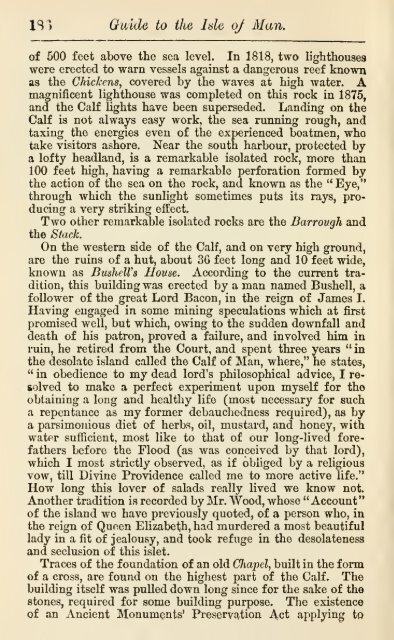Ward & Lock's descriptive and pictorial guide to the Isle of Man ...
Ward & Lock's descriptive and pictorial guide to the Isle of Man ...
Ward & Lock's descriptive and pictorial guide to the Isle of Man ...
Create successful ePaper yourself
Turn your PDF publications into a flip-book with our unique Google optimized e-Paper software.
ISl Guide <strong>to</strong> <strong>the</strong> <strong>Isle</strong> <strong>of</strong> <strong>Man</strong>.<strong>of</strong> 500 feet above <strong>the</strong> sea level. In 1818, two lighthouseswere erected <strong>to</strong> warn vessels against a dangerous reef knownas <strong>the</strong> Chickens, covered by <strong>the</strong> waves at high water. Amagnificent lighthouse was completed on this rock in 1875,<strong>and</strong> <strong>the</strong> Calf lights have been superseded. L<strong>and</strong>ing on <strong>the</strong>Calf is not always easy work, <strong>the</strong> sea running rough, <strong>and</strong>taxing <strong>the</strong> energies even <strong>of</strong> <strong>the</strong> experienced boatmen, whotake visi<strong>to</strong>rs ashore. Near <strong>the</strong> south harbour, protected bya l<strong>of</strong>ty headl<strong>and</strong>, is a remarkable isolated rock, more than100 feet high, having a remarkable perforation formed by<strong>the</strong> action <strong>of</strong> <strong>the</strong> sea on <strong>the</strong> rock, <strong>and</strong> known as <strong>the</strong> " Eye,"through which <strong>the</strong> sunlight sometimes puts its rays, producinga very striking effect.Two o<strong>the</strong>r remarkable isolated rocks are <strong>the</strong> Barrough <strong>and</strong><strong>the</strong> Stack.On <strong>the</strong> western side <strong>of</strong> <strong>the</strong> Calf, <strong>and</strong> on very high ground,are <strong>the</strong> ruins <strong>of</strong> a hut, about 3G feet long <strong>and</strong> 10 feet wide,known as BushelVs House. According <strong>to</strong> <strong>the</strong> current tradition,this building was erected by a man named Bushell, afollower <strong>of</strong> <strong>the</strong> great Lord Bacon, in <strong>the</strong> reign <strong>of</strong> James I.Having engaged in some mining speculations which at firstpromised well, but which, owing <strong>to</strong> <strong>the</strong> sudden downfall <strong>and</strong>death <strong>of</strong> his patron, proved a failure, <strong>and</strong> involved him inruin, he retired from <strong>the</strong> Court, <strong>and</strong> spent three years " in<strong>the</strong> desolate isl<strong>and</strong> called <strong>the</strong> Calf <strong>of</strong> <strong>Man</strong>, where," he states," in obedience <strong>to</strong> my dead lord's philosophical advice, I resolved<strong>to</strong> make a perfect experiment upon myself for thoobtaining a long <strong>and</strong> healthy life (most necessary for sucha repentance as my former debauchedness required), as bya parsimonious diet <strong>of</strong> herbs, oil, mustard, <strong>and</strong> honey, withwater sufficient, most like <strong>to</strong> that <strong>of</strong> our long-lived forefa<strong>the</strong>rsbefore <strong>the</strong> Flood (as was conceived by that lord),which I most strictly observed, as if obliged by a religiousvow, till Divine Providence called me <strong>to</strong> more active life."How long this lover <strong>of</strong> salads really lived we know not.Ano<strong>the</strong>r tradition is recorded by Mr. Wood, whose "Account"<strong>of</strong> <strong>the</strong> isl<strong>and</strong> we have previously quoted, <strong>of</strong> a person who, in<strong>the</strong> reign <strong>of</strong> Queen Elizabeth, had murdered a most beautifullady in a fit <strong>of</strong> jealousy, <strong>and</strong> <strong>to</strong>ok refuge in <strong>the</strong> desolateness<strong>and</strong> seclusion <strong>of</strong> this islet.Traces <strong>of</strong> <strong>the</strong> foundation <strong>of</strong> an old Cliapel, built in <strong>the</strong> form<strong>of</strong> a cross, are found on <strong>the</strong> highest part <strong>of</strong> <strong>the</strong> Calf. Thebuilding itself was pulled down long since for <strong>the</strong> sake <strong>of</strong> <strong>the</strong>s<strong>to</strong>nes, required for some building purpose. The existence<strong>of</strong> an Ancient Monuments' Preservation Act applying <strong>to</strong>
















